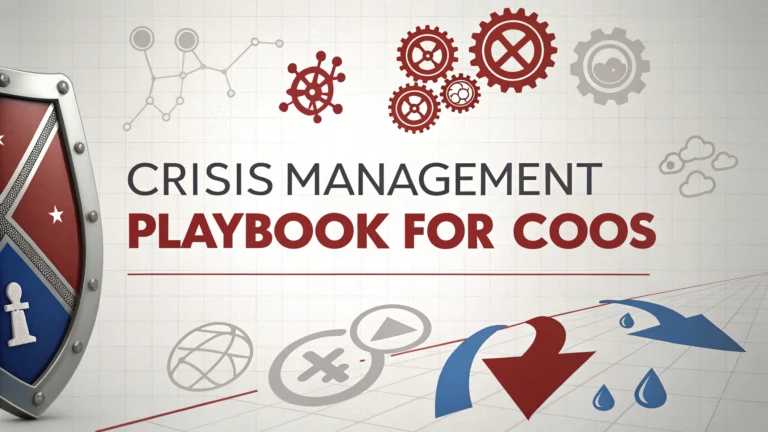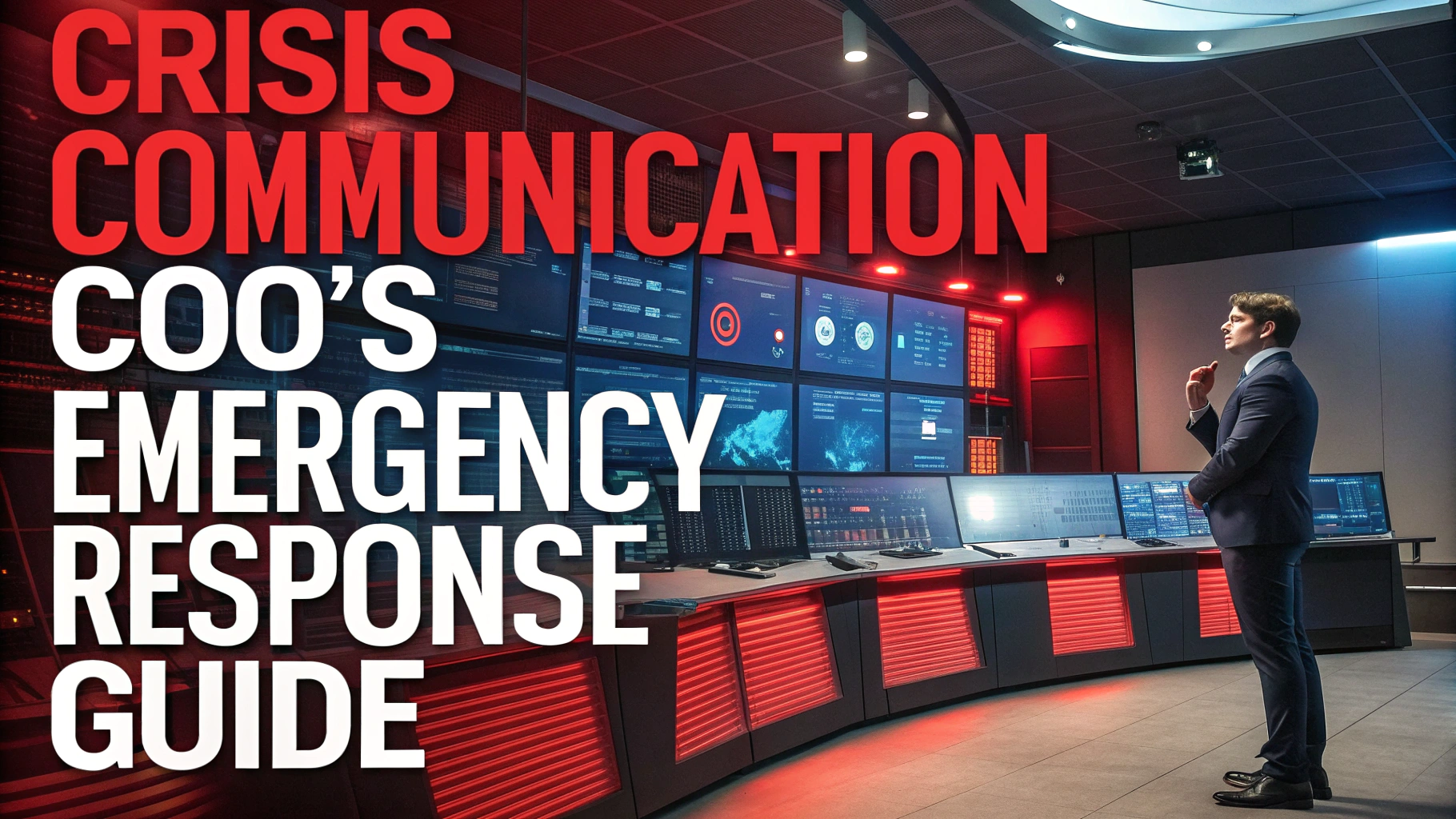A crisis management playbook helps Chief Operating Officers navigate unexpected challenges while maintaining operational stability.
This guide outlines practical strategies for COOs to handle various crisis scenarios, from natural disasters to cyber attacks.
Learn how to develop response protocols, coordinate teams, and protect your organization’s assets during critical situations.
Creating Your Crisis Response Framework
- Establish a Crisis Management Team (CMT)
- Define clear roles and responsibilities
- Create communication protocols
- Set up emergency contact lists
- Develop response templates
Essential Crisis Response Steps
- Initial Assessment
- Evaluate threat level
- Identify affected areas
- Calculate potential impact
- Immediate Action
- Activate response team
- Secure critical assets
- Notify stakeholders
- Communication
- Brief employees
- Update customers
- Inform shareholders
Risk Assessment Matrix
| Risk Level | Response Time | Team Activation |
|---|---|---|
| High | Immediate | Full CMT |
| Medium | Within 2 hours | Core team |
| Low | Within 24 hours | Department heads |
Business Continuity Planning
Map critical business functions and establish backup operational procedures.
Create redundancy plans for essential services and suppliers.
Set up remote work capabilities and alternative operating locations.
Communication Strategy
- Internal Communications
- Employee notification system
- Department updates
- Status reports
- External Communications
- Media statements
- Customer updates
- Regulatory reporting
Recovery and Post-Crisis Management
Document all actions taken during the crisis for future reference.
Conduct post-incident analysis to identify areas for improvement.
Update crisis management procedures based on lessons learned.
Emergency Contact Information
- Emergency Services: 911
- FBI Cyber Division: 855-292-3937
- FEMA Business Emergency Line: 800-621-3362
- CDC Emergency Response: 800-232-4636
Building Resilience for Future Challenges
Regular crisis simulation exercises strengthen team preparedness.
Update contact lists and procedures quarterly.
Maintain relationships with emergency response partners and local authorities.
Training and Development
- Crisis Response Training
- Annual team workshops
- Role-specific training modules
- Scenario-based exercises
- Skills Development
- Decision-making under pressure
- Emergency response protocols
- Leadership during crisis
Technology and Tools
Implement crisis management software and digital tools for rapid response.
Maintain secure backup systems and data recovery solutions.
- Emergency notification systems
- Asset tracking platforms
- Communication tools
- Data backup solutions
Stakeholder Management
Internal Stakeholders
- Board of Directors updates
- Employee engagement strategies
- Union communications
External Stakeholders
- Investor relations
- Supplier management
- Community engagement
Future-Proofing Your Organization
Build adaptable crisis response frameworks that evolve with emerging threats.
Invest in preventive measures and early warning systems.
- Regular risk assessments
- Technology updates
- Industry collaboration
- Knowledge sharing
Strengthening Organizational Resilience
Transform crisis experiences into organizational strength through systematic learning and adaptation.
Foster a culture of preparedness and continuous improvement.
Maintain strong leadership presence during recovery and rebuilding phases.
- Document best practices
- Share success stories
- Recognize team contributions
- Build lasting partnerships
FAQs
- What are the key components of an effective crisis management playbook for COOs?
A crisis management playbook should include clear communication protocols, emergency contact lists, role assignments, decision-making frameworks, stakeholder management guidelines, business continuity plans, and recovery strategies. - How often should a crisis management playbook be updated?
Crisis management playbooks should be reviewed and updated quarterly, with comprehensive revisions annually or after any major incident, organizational change, or lessons learned from crisis simulations. - What role does the COO play during a crisis situation?
The COO serves as the operational commander, coordinating response teams, maintaining business continuity, implementing mitigation strategies, managing resources, and ensuring alignment between crisis response and overall business objectives. - How should a COO prioritize different types of crises?
Crises should be prioritized based on potential impact to human safety, business continuity, financial stability, reputation, and regulatory compliance, using a risk assessment matrix to evaluate likelihood and severity. - What communication protocols should be established in a crisis management playbook?
Communication protocols should detail internal and external communication chains, spokesperson designation, media response procedures, stakeholder notification sequences, and multiple communication channel backup plans. - How can COOs ensure business continuity during a crisis?
COOs should maintain updated business continuity plans, establish clear succession plans, identify critical business functions, secure alternate operational sites, and maintain redundant systems for essential operations. - What metrics should COOs monitor during a crisis?
Key metrics include operational stability indicators, financial impact measures, employee safety statistics, stakeholder response rates, recovery timeline progress, resource allocation efficiency, and crisis containment effectiveness. - What legal considerations should be included in a crisis management playbook?
Legal considerations should cover regulatory compliance requirements, documentation protocols, liability protection measures, insurance coverage details, contractual obligations, and legal reporting requirements during different types of crises. - How should crisis response teams be structured under the COO’s leadership?
Crisis response teams should include cross-functional representatives, clear reporting lines, designated alternates, specific role assignments, decision-making authority levels, and expertise-based task forces. - What recovery and post-crisis procedures should be included in the playbook?
Recovery procedures should outline damage assessment protocols, resource reallocation plans, stakeholder recovery communication, operational normalization steps, lessons learned documentation, and playbook revision processes.








